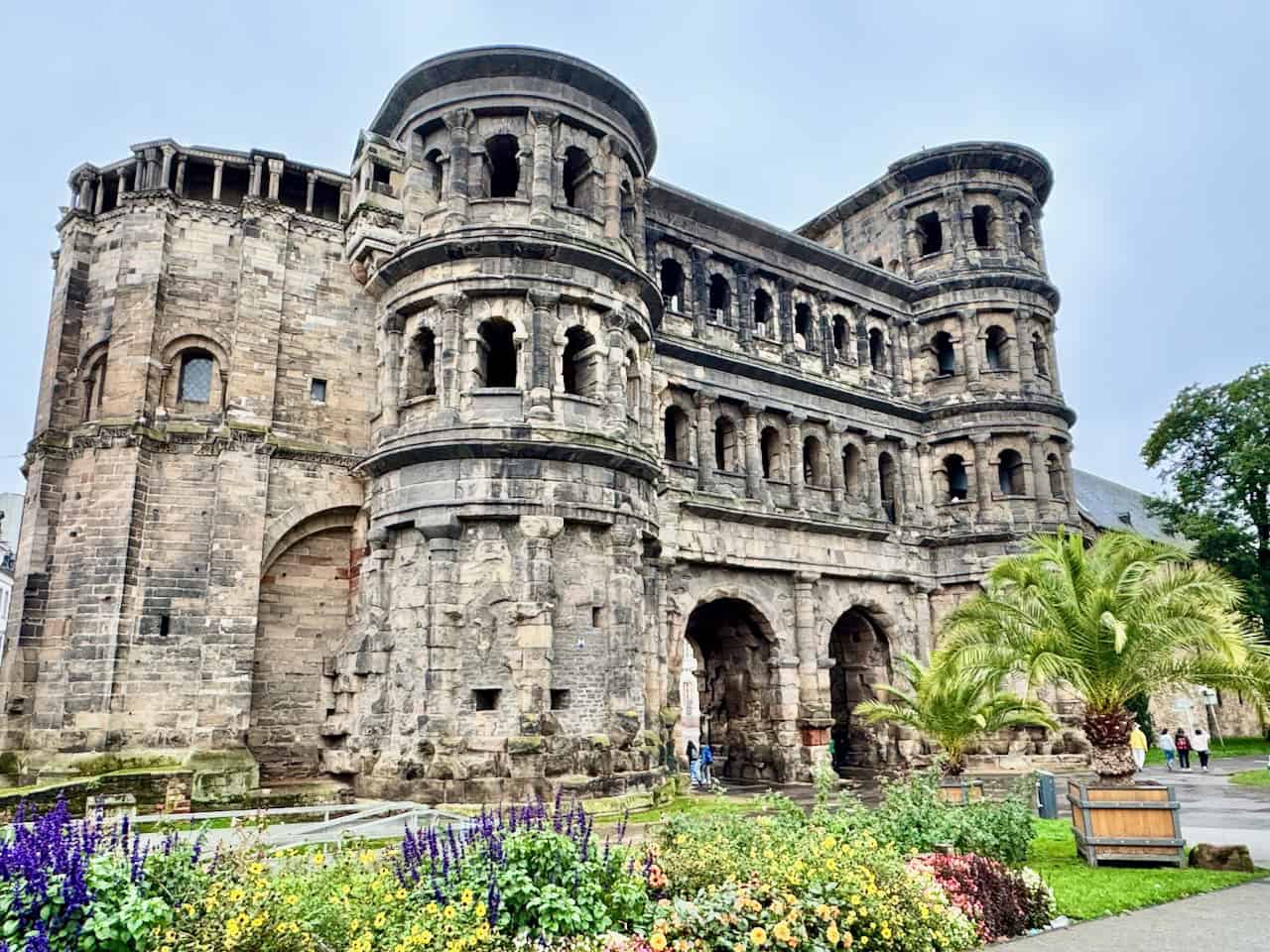
Trier, founded by the Romans in the 1st century B.C. and known as Germany’s oldest city, is located on the banks of the Moselle River near the border with Luxembourg. During my visit to Trier, I discovered a city packed with remarkable Roman monuments, medieval buildings and delightful restaurants and wine taverns. There are many things to see and do in Trier – aside from its UNESCO World Heritage listed monuments, I found a wonderful mix of medieval charm, impressive museums, serene parks and lively squares. Trier is also the gateway to one of Germany’s most scenic wine regions, the Moselle Valley, which is famous for its terraced vineyards and crisp Riesling wines. In this travel guide, I’ve listed the top things to see in Trier, including a two-day itinerary and a sightseeing walking route, as well as additional tips for scenic hikes and tours, wine-tasting and dining.
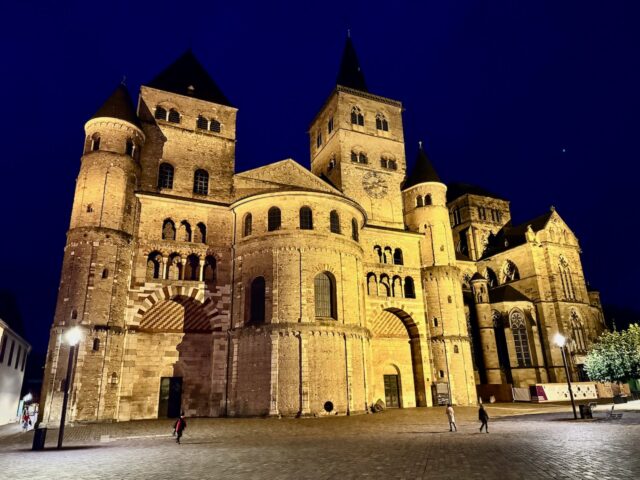 Trier Cathedral
Trier Cathedral

A brief history of Trier
Founded by the Romans in 16 B.C. as Augusta Treverorum, Trier quickly became one of the most important cities in the Roman Empire north of the Alps. By the 4th century, it was even the residence of several Roman emperors, overseeing much of the Western Roman Empire. In the 5th century, the Franks took control of Trier from the Romans and the city became part of East Francia, which later evolved into the Holy Roman Empire (10th century). In the Middle Ages, many of the Roman structures were used as foundations for other buildings or converted into churches and castles.
Over the centuries, Trier evolved into a cultural and spiritual centre of the region. Today, its rich tapestry of Roman, medieval and modern influences is visible at every turn – from colossal stone gates and imperial baths to Gothic cathedrals and Baroque palaces. The city is a UNESCO World Heritage Site, home to impressive Roman monuments and a charming old town that reflects more than two millennia of history.
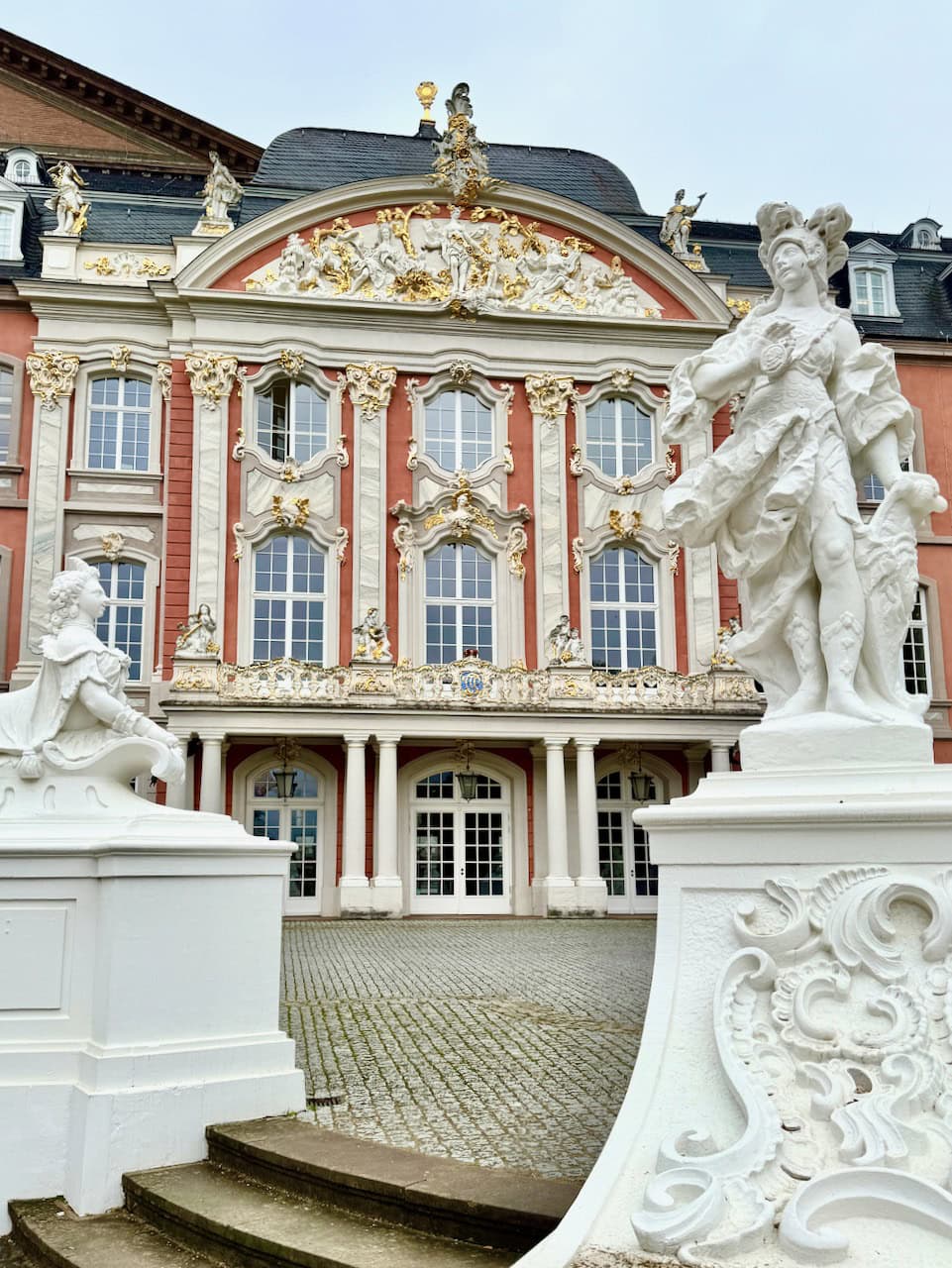 Electoral Palace
Electoral Palace
I visited Trier as part of a rail tour along the Rhine and Moselle rivers in western Germany. During this tour, I visited four of the 17 Historic Highlights of Germany heritage cities. These heritage cities, which are typically university towns, combine rich history with vibrant culture and cuisine. Best of all, they’re wonderfully walkable.
There’s a lot to see and do in Trier so I recommend a stay of at least two nights. This enables you to tour the amazing Roman monuments, learn about the city’s colourful history, indulge in its wine and culinary offerings, and enjoy the beautiful natural surroundings. For entrance to the Roman sites, you can purchase an Antikencard online or at the tourist office (next door to Porta Nigra). The card provides access to 2 or 4 Roman sites as well as the State Museum. Here’s a suggested two-day itinerary:
Trier 2-day itinerary
Day 1
- Morning: visit Porta Nigra, Hauptmarkt and Trier Cathedral
- Afternoon: after lunch, visit the Aula Palatina (Basilica of Constantine), Electoral Palace and Rheinisches Landesmuseum. Continue to the Trier Amphitheatre and Petrisberg.
- Evening: enjoy a glass of wine with locals at the Weinstand in Hauptmarkt before tucking into dinner at a cosy restaurant.
Day 2
- Morning: visit the Imperial Baths and the Roman Bridge. Stroll along the Moselle River.
- Afternoon: Lunch in Zurlaubener Ufer, a charming riverside neighbourhood, before embarking on a scenic Moselle River cruise.
- Evening: enjoy a wine-tasting before dinner.
There are numerous hotels in Trier’s city centre. I stayed at the Hotel Porta Nigra Victus, a comfortable hotel a stone’s throw from Porta Nigra, and a 10-minute walk from the central station. Search for accommodations (Booking.com) in Trier.
Trier self-guided walking tour
The map below shows the main attractions in Trier as well as my self-guided walking tour, which can comfortably be done in two days. You’ll also find descriptions of the main attractions in Trier in the same sequence as the walking route. Alternatively, you can join a guided walking tour with wine-tastings along the way!
Porta Nigra
Start your walking tour of Trier at the imposing Porta Nigra. No visit to Trier is complete without seeing the Porta Nigra, the city’s most iconic landmark and one of the best-preserved Roman city gates in the world. Built around 180 A.D., this massive sandstone structure once guarded the northern entrance to the Roman city.
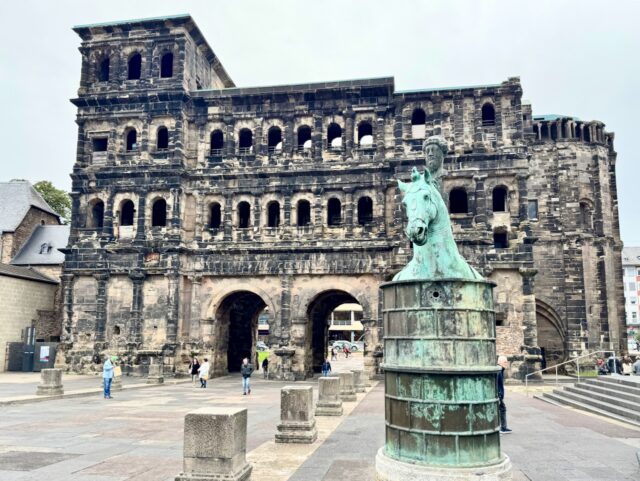 Porta Nigra, the Roman gate
Porta Nigra, the Roman gate 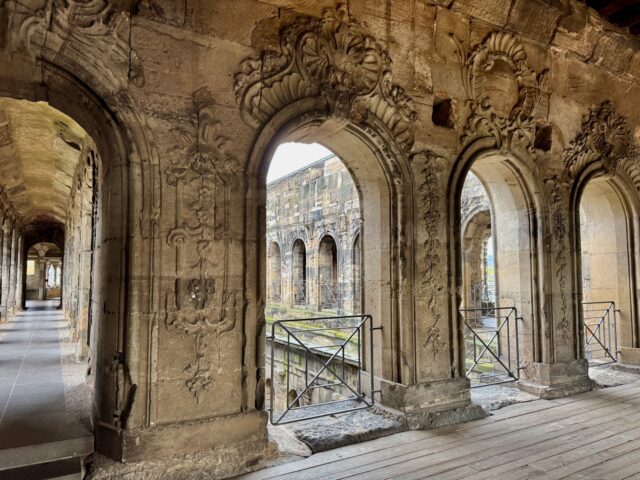 Inside the Porta Nigra
Inside the Porta Nigra
I recommend climbing to the top for panoramic views of Trier’s Old Town. Inside, you’ll also find a small exhibition detailing the gate’s fascinating transformation over the centuries, including its time as a church in the Middle Ages. One thing I found fascinating was that thanks to Napoleon Bonaparte, the church was demolished and the Porta Nigra was converted back to its original Roman form in 1804.
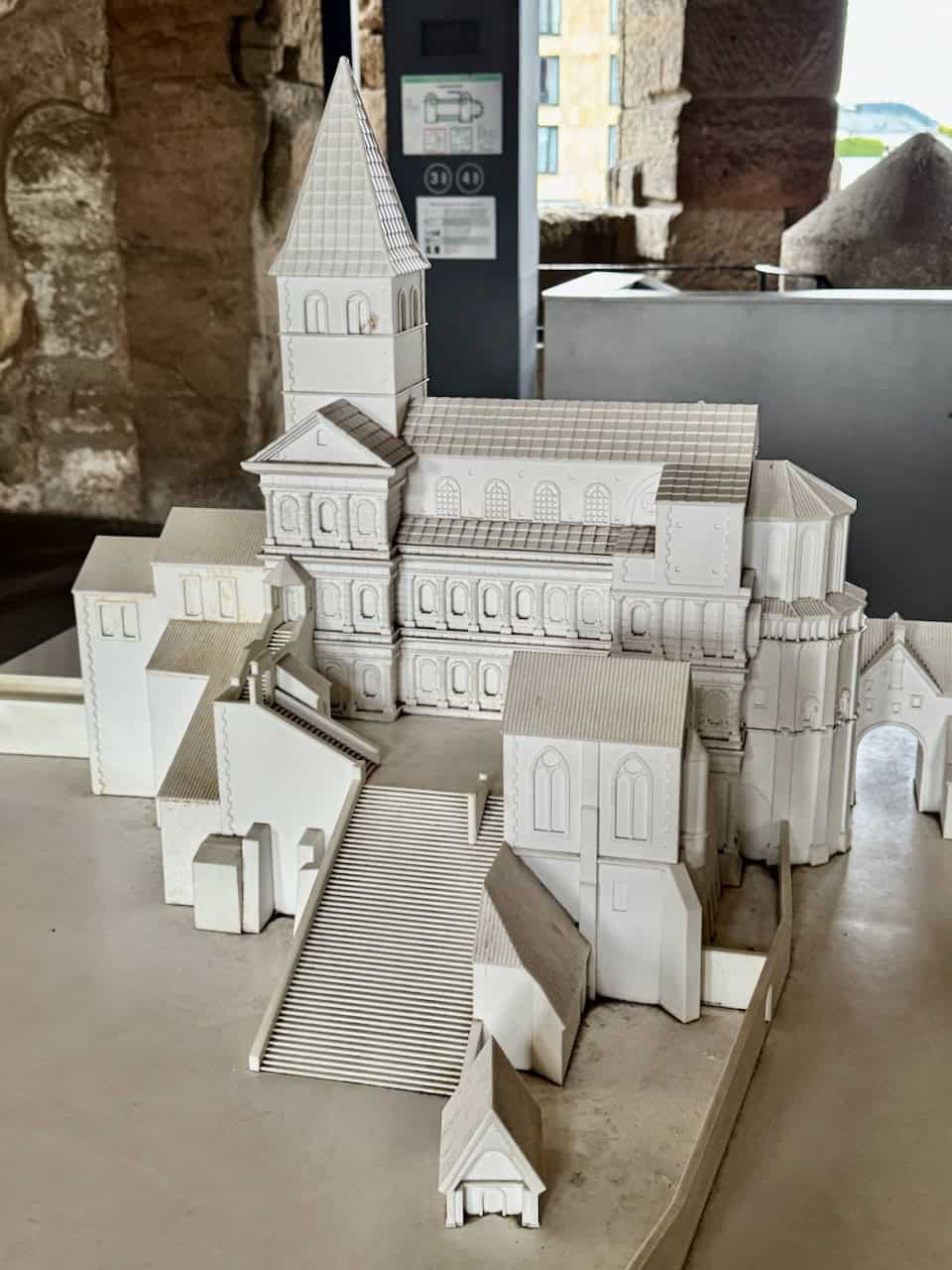 Model of what the Porta Nigra looked like as a basilica during the Middle Ages.
Model of what the Porta Nigra looked like as a basilica during the Middle Ages.
In the square fronting the Porta Nigra, you’ll find a model of the old Roman city. The model gives you an idea of the scale and grandeur of the city during Roman times.
Simeonstrasse
From the Porta Nigra, continue down Simeonstrasse in the direction of Hauptmarkt. This broad, pedestrian street is home to numerous shops, restaurants and cafés, as well as various historic gems:
Dreikönigenhaus
A classic example of medieval Trier is the Dreikönigenhaus (House of the Three Magi). This 13th century building now houses a coffee shop but was once the glamorous home of a wealthy Trier family. Notice the mix of Byzantine, Romanesque and Gothic styles. Another interesting element is the main door, which is located on the first floor. In medieval times, the door was reached by a ladder, which could be raised during an attack.
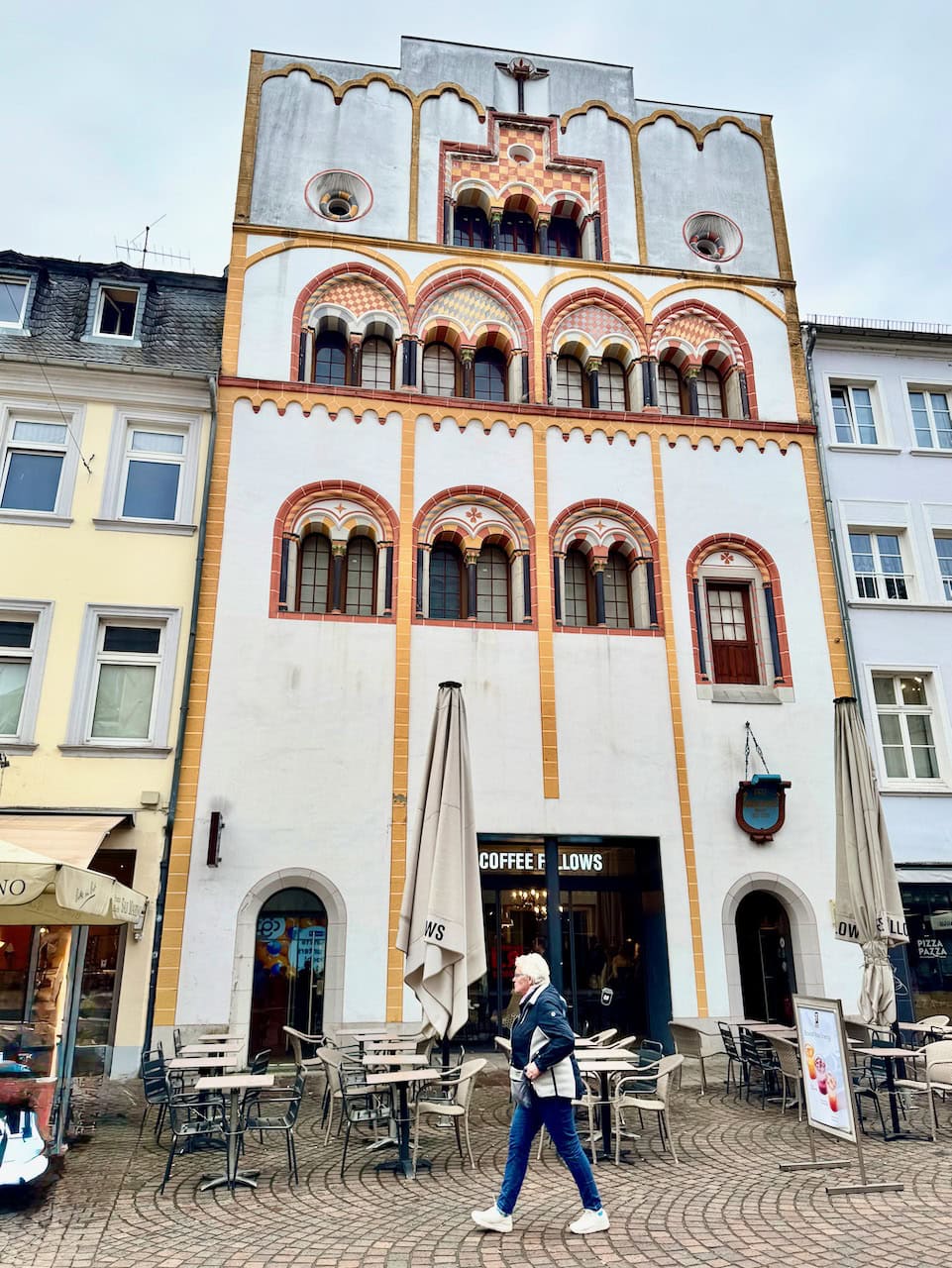 Dreikönigenhaus – notice the main door on the first floor
Dreikönigenhaus – notice the main door on the first floor
Half-timbered houses
At the entrance to Judengasse (Jewish Alley), you’ll find three of the few medieval half-timbered houses left in Trier.
 Half-timbered houses
Half-timbered houses
Hauptmarkt
At the heart of Trier lies the Hauptmarkt, a lively market square surrounded by colorful medieval buildings, shops and cafés. This bustling plaza has been the city’s commercial centre since the Middle Ages.
 Hauptmarkt
Hauptmarkt
Key sights include the Market Cross (dating back to 958 A.D.), St. Peter’s Fountain, the medieval St. Gangolf Church (accessible via a Baroque gate on the square), the 17th century Red House and a charming mix of Gothic and Renaissance facades. It’s the perfect place to enjoy a coffee, people-watch or sample local pastries before continuing your exploration.
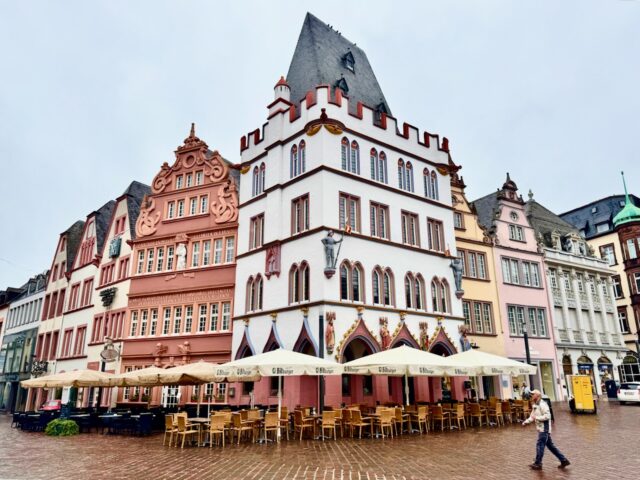 Red House and Steipe at the Hauptmarkt
Red House and Steipe at the Hauptmarkt
One of the most beautiful buildings on the Hauptmarkt is Steipe. Built in the 15th century with contributions from Trier’s citizens, Steipe is a late-Gothic style building with curious-looking statues of two knights on its façade. One knight, with an open visor, watches the square, while the other has his visor closed. Look closely and you’ll see his eyes peeled in the direction of the Cathedral, and his genitals exposed – a jibe at the religious leaders of the time. Steipe was reduced to rubble during WWII but was lovingly restored with donations from locals.
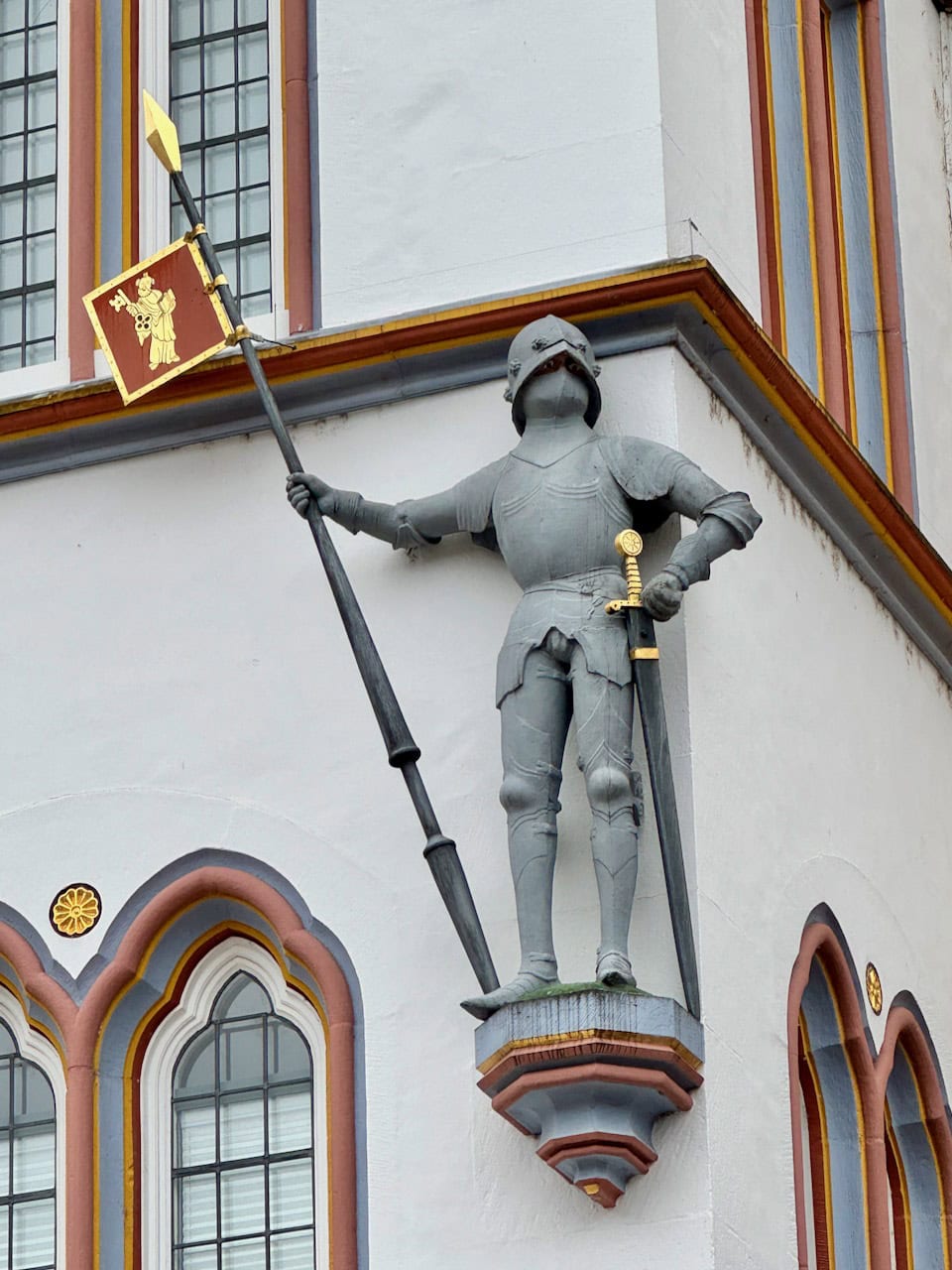 The knight on the façade of Steipe with his visor down and genitals exposed.
The knight on the façade of Steipe with his visor down and genitals exposed.
At Hauptmarkt, you’ll also find the Weinstand. This permanent wine booth is a popular social spot for locals and visitors alike. Local wineries take turns to man the booth and showcase their wines.
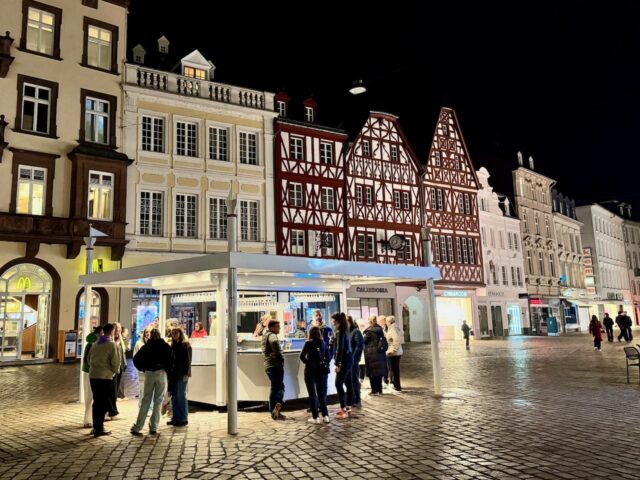 Weinstand Trier at Hauptplatz
Weinstand Trier at Hauptplatz
In December, the Hauptmarkt transforms into one of Germany’s most picturesque Christmas markets, with wooden stalls selling mulled wine, handmade gifts, and festive treats.
Trier Cathedral
A short stroll from the Hauptmarkt lies the Domfreihof, an impressive square overlooked by the stunning Trierer Dom (Trier Cathedral) and the Liebfrauenkirche (Church of Our Lady), a neighbouring Gothic church that forms part of Trier’s UNESCO World Heritage ensemble.
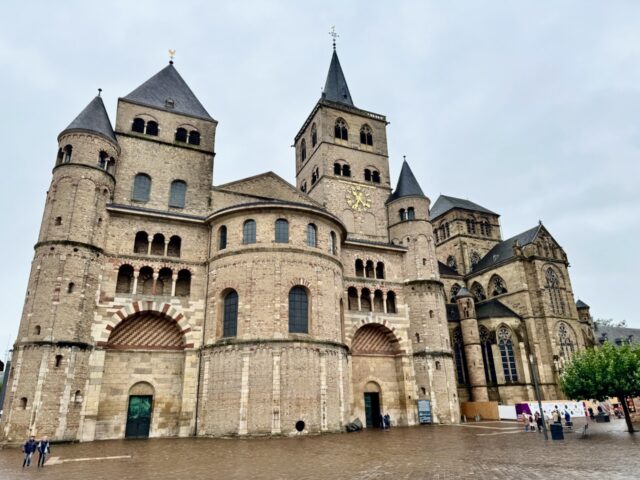 Trier Cathedral (left) and Church of Our Lady (right)
Trier Cathedral (left) and Church of Our Lady (right)
Entrance is free and inside, you’ll find centuries of artistry and faith on display, from intricate stone carvings and golden reliquaries to soaring vaulted ceilings. The Cathedral also houses one of Christianity’s most sacred relics: the Holy Tunic, believed to be the robe worn by Jesus before his crucifixion. It’s displayed to the public only on rare occasions.
 Inside the Cathedral
Inside the Cathedral
Stroll around the cloister gardens, where you’ll have a stunning view of the Cathedral ‘skyline’, and visit the Cathedral Treasury (a ticket is required), with its impressive collection of religious artifacts.
 Trier Cathedral cloister
Trier Cathedral cloister
Layers of history
Originating in the 4th century and consequently expanded across the centuries, the Trier Cathedral is a showcase of Roman, Romanesque and Gothic elements. These layers of history are easy to spot, particularly along the north façade, or from the peaceful cloister gardens. The north façade is especially interesting as it includes 4th century Roman brickwork, 11th century Romanesque architecture and 21st century engineering techniques to keep this massive structure intact!
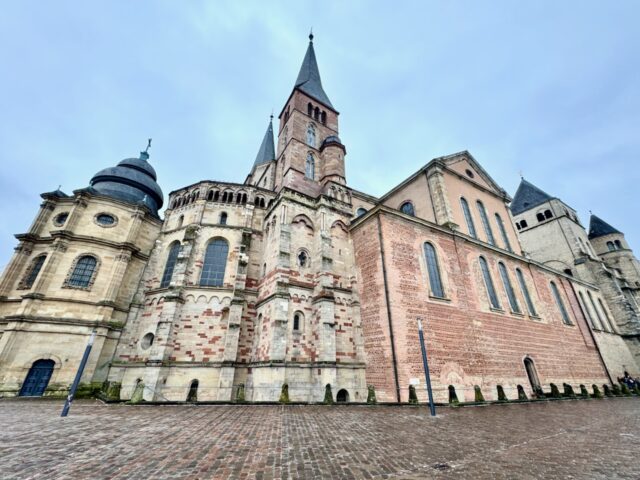 North façade of Trier Cathedral
North façade of Trier Cathedral  Roman brickwork on the north façade.
Roman brickwork on the north façade.
Aula Palatina – Basilica of Constantine
Our next stop is the Aula Palatina or Basilica of Constantine. Commissioned by Emperor Constantine in the early 4th century, it’s one of the best-preserved Roman structures in Trier. Originally built as an imperial throne hall for Emperor Constantine, its immense brick interior is an awe-inspiring sight.
 Aula Palatina
Aula Palatina
The hall’s sheer size, 67m long and 33m high, symbolises the power and authority of the Roman emperors. Today, the building serves as a Protestant church, and visitors can admire its minimalist interior and striking sense of space.
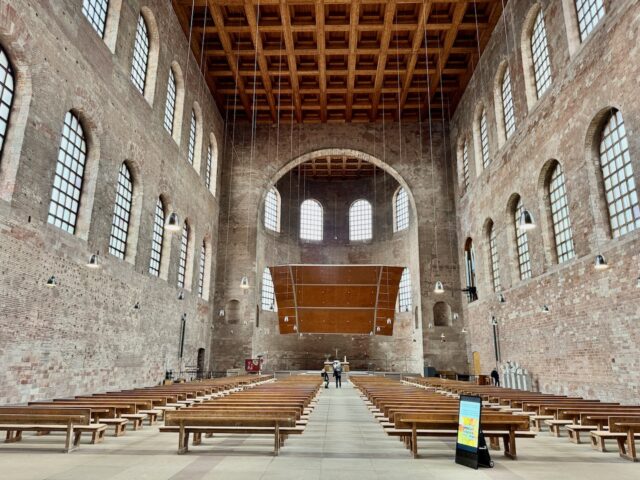 Aula Palatina, the Throne Hall of Emperor Constantine
Aula Palatina, the Throne Hall of Emperor Constantine
Outside, the adjoining Electoral Palace (Kurfürstliches Palais) adds a touch of Baroque elegance, with ornate gardens that are perfect for a stroll.
 Electoral Palace and its gardens
Electoral Palace and its gardens
Rheinisches Landesmuseum
At the edges of the gardens of the Electoral Palace, you’ll find the Rheinisches Landesmuseum or Rhineland State Museum. I highly recommend visiting this museum, one of the most important archaeological museums in Germany, to see its outstanding collection of Roman mosaics, frescoes and sculptures.
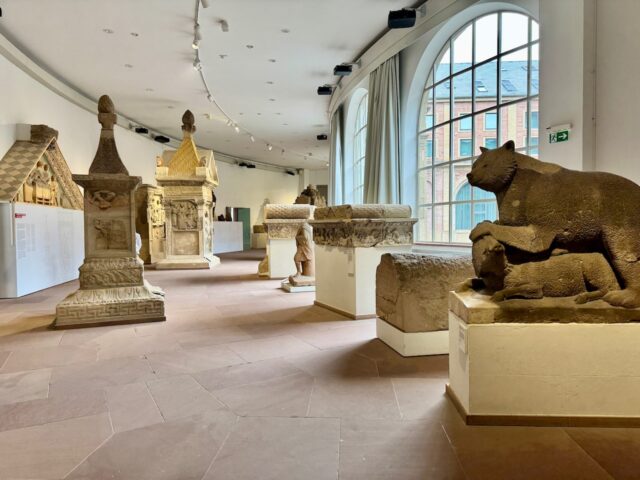 Rhineland State Museum in Trier has an impressive collection of Roman artifacts.
Rhineland State Museum in Trier has an impressive collection of Roman artifacts.  Roman mosaics at the Rhineland State Museum
Roman mosaics at the Rhineland State Museum
The museum also houses Germany’s largest collection of Roman coins, a hoard of thousands of gold coins found in Trier in 1993.
 Roman gold coins
Roman gold coins
Trier Amphitheatre
A ±15-minute walk from the museum lies Trier’s Roman Amphitheatre. Built around 100 A.D. into the slope of the Petrisberg hill, it could once seat up to 20,000 spectators, hosting gladiatorial contests, animal hunts and public spectacles.
 Trier Amphitheatre (image by A.Schimmeck/Unsplash)
Trier Amphitheatre (image by A.Schimmeck/Unsplash)
Today, the amphitheatre is remarkably well-preserved, allowing visitors to walk through the same tunnels where gladiators once awaited their fate. In summer, the site often hosts historical reenactments, open-air concerts and plays.
Weinkulturpfad
If you have time and enjoy a little hike, I recommend the Weinkulturpfad (Wine Culture Path). This path leads through the vineyards on the slopes of the Petrisberg hill. Along the way, you’ll get to learn about the grape varieties grown in the area and enjoy beautiful views of Trier. The path starts just outside the Amphitheatre.
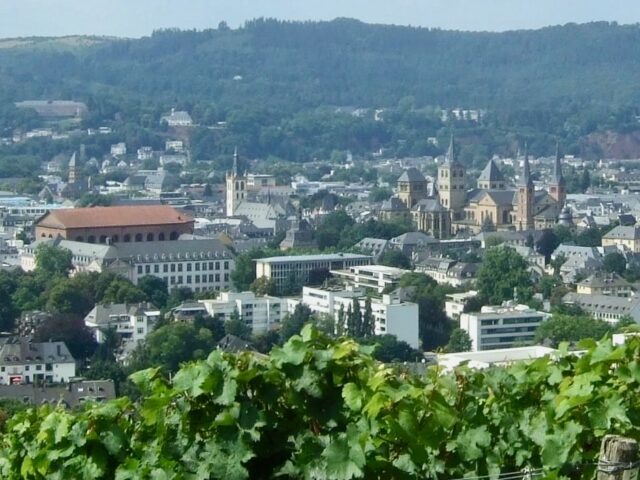 Trier view from the Wine Culture Path on Petrisberg (image by Trier/Wikimedia Commons).
Trier view from the Wine Culture Path on Petrisberg (image by Trier/Wikimedia Commons).
Roman baths
There are numerous ruins of Roman baths in Trier, the largest of which are the Kaiserthermen, or Imperial Baths. These vast ruins once formed part of an enormous bath complex constructed in the 4th century for Emperor Constantine’s residence. It was never fully completed, and in the Middle Ages, it was used as a castle.
 Imperial Baths
Imperial Baths
The site remains one of the largest and best-preserved Roman bathhouses outside Italy. Visitors can explore the subterranean tunnels and ancient heating systems that reveal how advanced Roman engineering was.
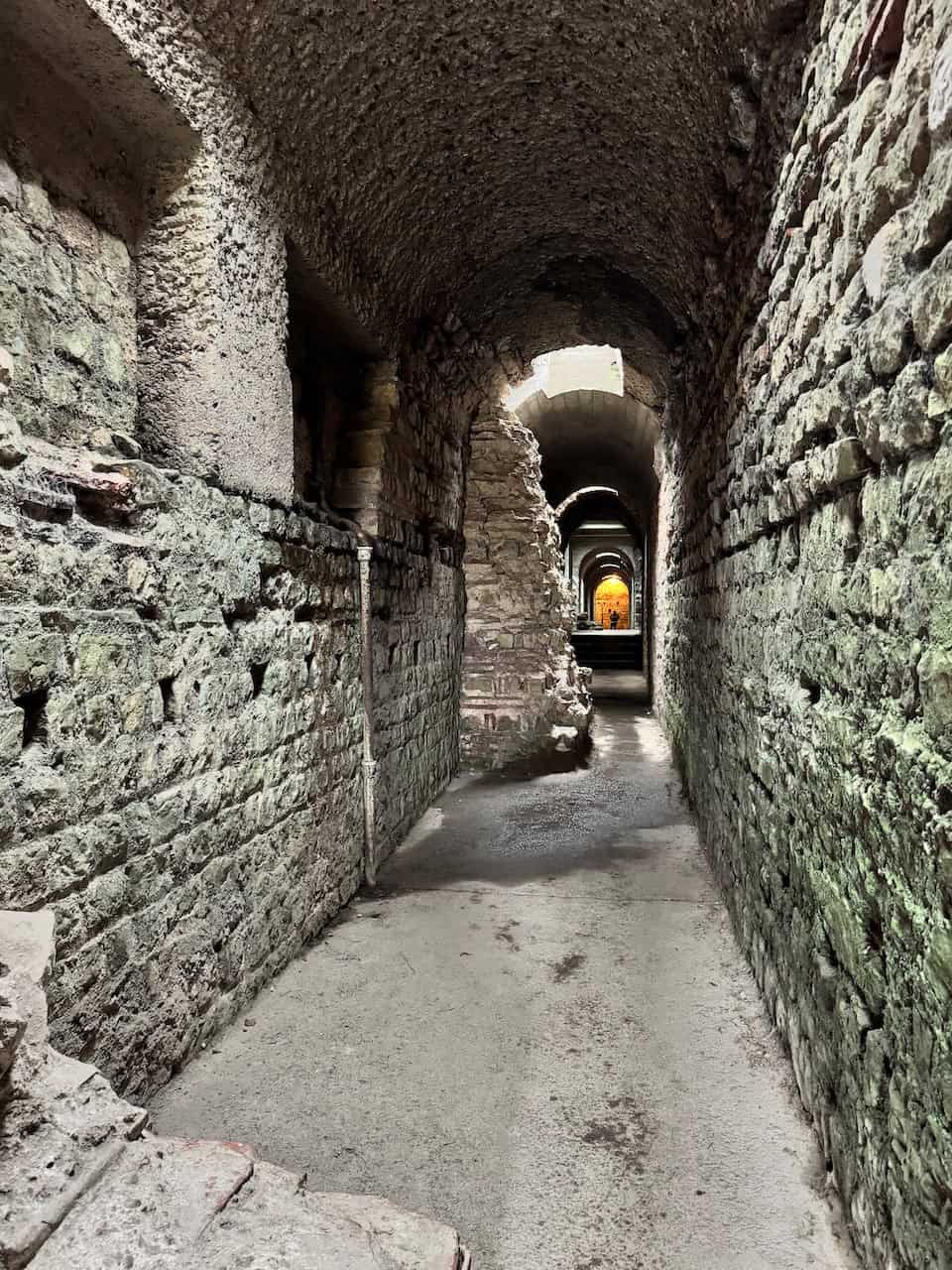 Tunnels under the Imperial Baths
Tunnels under the Imperial Baths
The largest bath was the Barbarathermen or Barbara Baths. Built in the 2nd century A.D., this is the largest Roman bath complex outside of Rome! However, not much of this huge complex exists today.
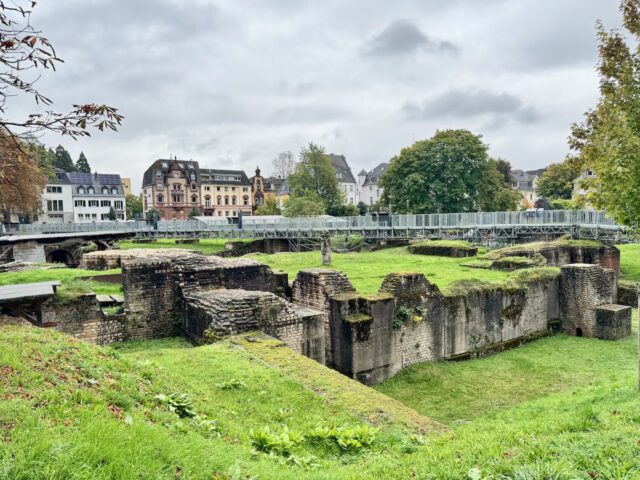 The Barbara Baths was once the largest Roman bathing complex outside Rome.
The Barbara Baths was once the largest Roman bathing complex outside Rome.
Discovered in 1987, the Thermen am Viehmarkt, or Forum Baths, is another Roman bath complex. Over the centuries, parts of the baths were used to build other structures in the city. The site itself was converted into a cattle market, hence the name Viehmarkt (cattle market).
Karl Marx House
Trier is also the birthplace of philosopher and economist Karl Marx. His birthplace, a Baroque-style townhouse, is now the Karl Marx House Museum.
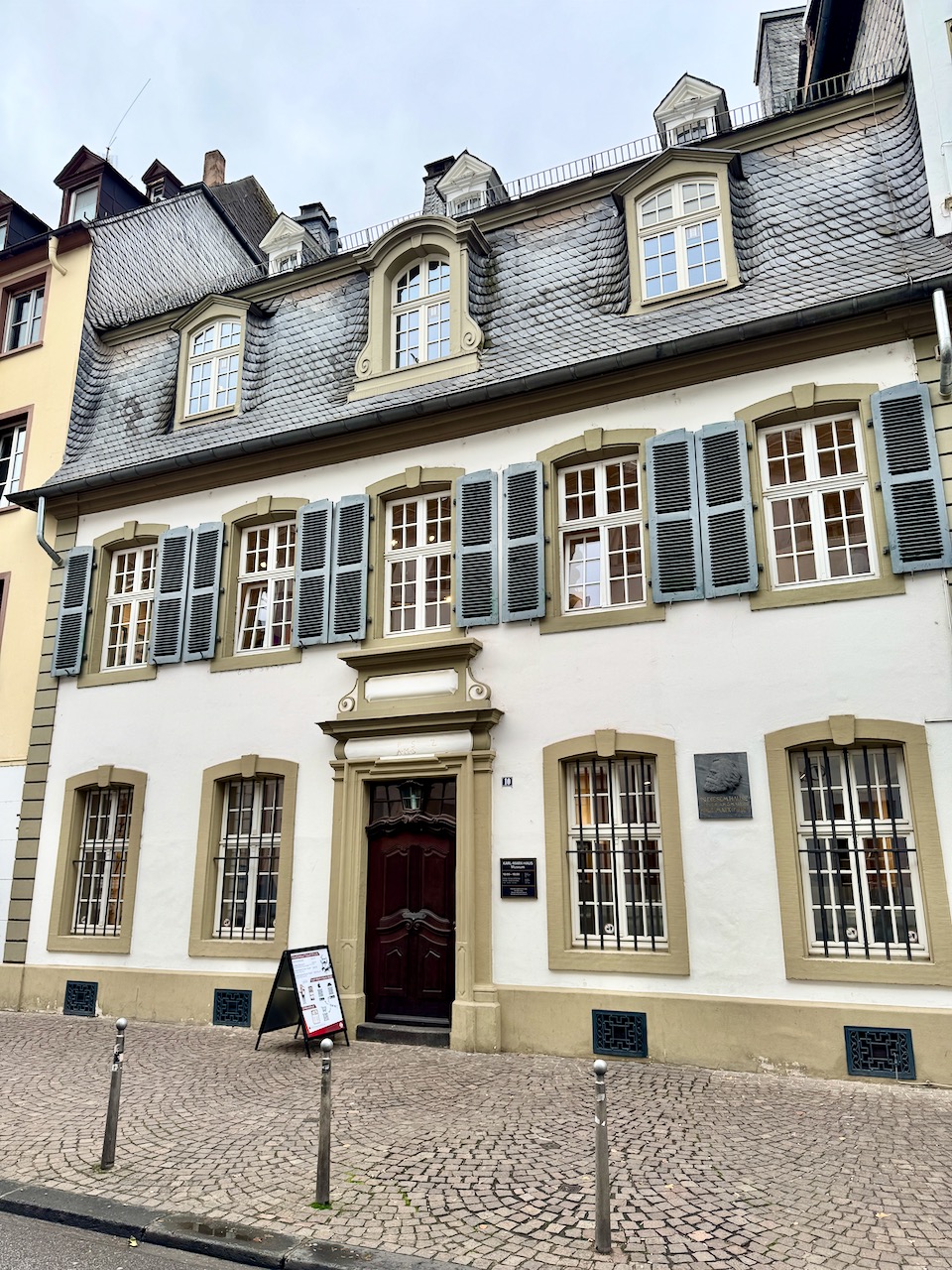 Karl Marx House Museum
Karl Marx House Museum
The museum provides an engaging look at Marx’s life, his revolutionary ideas and their influence on modern history. It’s an interesting stop for anyone interested in politics, philosophy or social history.
Roman Bridge
Spanning the Moselle River, Trier’s Roman Bridge is the oldest bridge north of the Alps still in use today. Its stone piers date back to the 2nd century AD and have withstood countless floods, wars and centuries of use.
 Roman Bridge
Roman Bridge
Moselle embankment
From the Roman Bridge, enjoy a serene stroll along the Moselle embankment, with its lush greenery and river views, towards Zurlauben. Along the way, you’ll pass two historic cranes which were used to haul goods from river barges. The oldest crane, the Alter Krahnen, commenced operations in 1452!
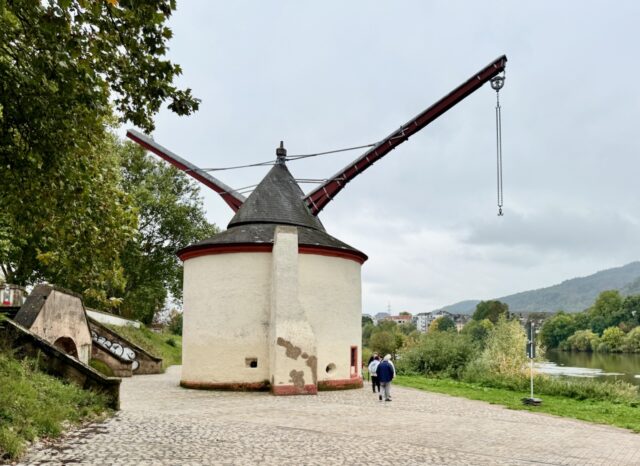 Alter Krahnen
Alter Krahnen
Zurlaubenufer
The Zurlauben shore consists of a row of charming 18th century houses, many of which have been converted into restaurants. This is the perfect spot to enjoy a refreshment and a meal. If you love fried chicken, don’t miss Flieten Franz!
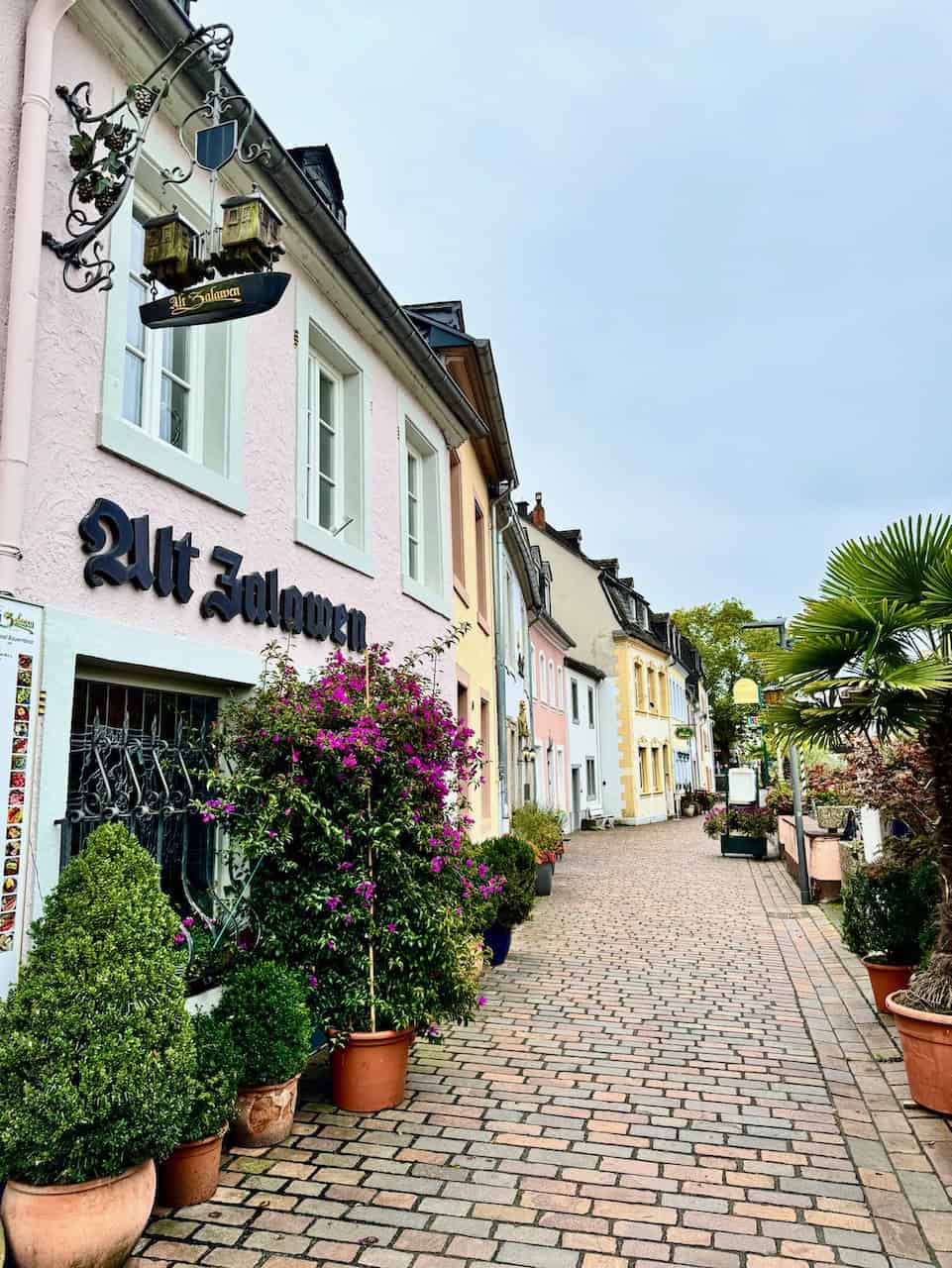 Zurlaubenufer
Zurlaubenufer
Zurlaubenufer is also the embarkation point for Moselle River cruises. There’s a cruise at 3pm that combines river views with a bus excursion to a local winery for a wine-tasting/meal.
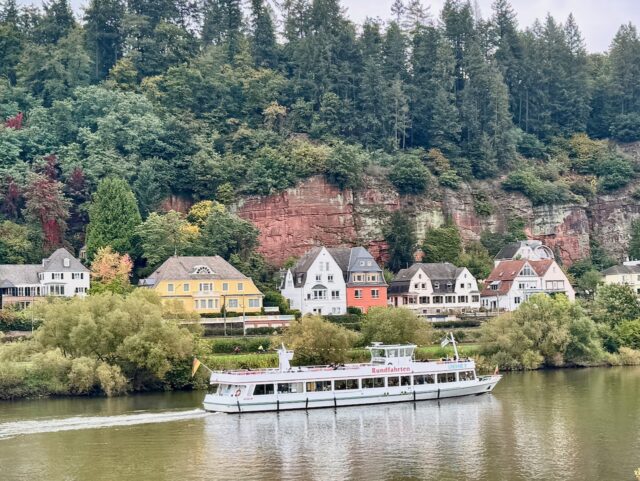 Mosselle River cruise
Mosselle River cruise
From Zurlaubenuber, it’s a ±15-minute walk back to Porta Nigra in the centre of Trier.
Where to wine and dine in Trier
There’s no shortage of terrific restaurants, atmospheric wine taverns and historic wine cellars in Trier. I’ve pinned the following places on the map above.
To taste some of the local wines, I recommend a visit to Weinstand (Hauptmarkt) or Goldmund Wein & Freunde at Glockenstraße 10 (check ahead for their wine-tasting events). Weinbar Trier, near Porta Nigra, is a casual bar with an excellent collection of wines.
 Wine-tasting at Goldmund Wein & Freunde
Wine-tasting at Goldmund Wein & Freunde
Fancy a tour of a Germany’s oldest wine cellar (built in 330A.D.!) coupled with a wine-tasting? Then head to Vereinigte Hospitien (Krahnenufer 19) for an unforgettable tour.
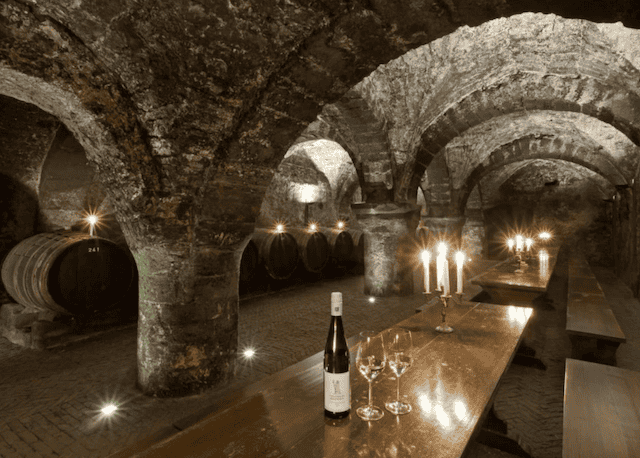 Vereinigte Hospitien cellar (image courtesy of Vereinigte Hospitien)
Vereinigte Hospitien cellar (image courtesy of Vereinigte Hospitien)
For a delightful meal, I recommend Weinstube Kesselstatt (Liebfrauenstraße 10), near the Cathedral; Weinwirtschaft Friedrich-Wilhelm (Weberbach 75) near the Aula Palatina; and Brasserie Zur Sim (Simeonstraße 59) near Porta Nigra.
 Weinstube Kesselstatt
Weinstube Kesselstatt
While exploring Trier, I stopped for lunch at Textorium (Wechselstraße 4, near the Imperial Baths) and loved the youthful vibes, industrial setting and delicious food.
If you enjoy seafood and wines, head to Oechsle Wein- und Fischhaus (Palaststraße 5-7).
How to get to Trier
Trier is well-connected by road and rail. There are frequent direct train services, or via Koblenz, from Cologne. From major German cities such as Frankfurt and Munich, change trains in Mannheim. There is also a direct train service from Luxembourg. If you’re taking the train or driving from Koblenz, Saarbrücken or Luxembourg, you’ll be treated to simply gorgeous scenery along the way!
 Beautiful scenery along the Moselle River from Koblenz to Trier
Beautiful scenery along the Moselle River from Koblenz to Trier
Read more about other Historic Cities of Germany
Note: my visit to Trier was made possible in partnership with Historic Highlights of Germany. As always, all views expressed above are mine, and mine only.
Please visit:
Our Sponsor
